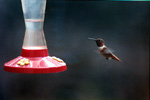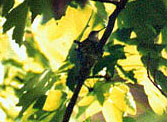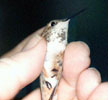


The Problem
Buff-bellied Hummingbird
Ruby-throated Hummingbird
Black-chinned Hummingbird
Anna's Hummingbird
Bahama Woodstar
Calliope Hummingbird
Broad-tailed Hummingbird
Rufous Hummingbird
Allen's Hummingbird
At least three other species have been reported in the state but were not adequately documented to be accepted by the State Records Committee: Cuban Emerald, Broad-billed Hummingbird, and Magnificient Hummingbird. Other species including Green Violet-ear (Alabama, North Carolina), Blue-throated Hummingbird (Alabama), White-eared Hummingbird (Mississippi) and Green-breasted Mango (North Carolina) may soon occur in Florida. These and other species may have already occurred in the state and gone unnoticed due to a shortage of observers and/or a lack of knowledge in identification. Go to https://rowdy13.tripod.com/floridahummers/records.html to view a list of some Florida hummingbird sightings from the past few years.
It is important that observers be aware of the possibility and probability that a hummingbird seen in Florida may be a species other than Ruby-throated. Most of the field guides and books on bird feeding and attracting hummingbirds do not emphasize any species other than the Ruby-throated as occurring in the east although some acknowledge the rare occurrence of Rufous Hummingbirds. These were the only 2 species listed in Peterson's Field Guide to Eastern Birds. The Sibley Guide to Birds is the only field guide I own that shows occurrences of these western hummingbirds in Florida.
Many hummingbird observations are of a bird at flowers (or a feeder) some distance away. Their visits may only be for a few fleeting seconds to a few minutes every hour or so and often occur without the aide of binoculars. Many of these western strays are either females or young birds which can be difficult even for experienced birders to identify. In most cases, it's easier to say "hummingbird" and marvel at its being than to try to identify it.
Most birders are hummingbird watchers of one form or another but many hummingbird watchers are not birders. If identification is difficult and the birding literature does not reference the possibility of these western and Caribbean strays occurring here, how is the average observer to know what they are seeing?
Twenty five years ago, most of these species were not believed to occur in the east. Dennis Demcheck summarized the last 25 years of hummingbird study in the Baton Rouge area in a Post to Humnet. I believe Florida is in a similar position to where they were in the late 70's. There are a lot more hummingbirds in Florida than we realize.
I want to collect all the data possible on Florida's wintering and summering hummingbirds. My main goal is to document and record the numbers of each species spending any time in Florida between mid-October and early-March. I'm also interested in showing the number of hummingbirds potentially breeding here by recording the birds observed in breeding behavior and those who make regular visits during the month of June.
First date observed
Last date observed (if applicable)
Species
Sex
Age
City
County
If feeding at Feeder
If feeding at Flowers
Any additional comments are encouraged.
( *** Due to unexpected requirements of my time, I have not been able to follow through with my plans to graphically represent the data. I'm still collecting data and will eventually be able to post the results. In the meantime, please continue to e-mail me your sightings and/or questions regarding hummingbirds in Florida. April 2009. *** I'm currently maintaining an information site including a blog on the bird activity in my yard at http://mysite.verizon.net/resu64md/yardhummers/
I'm also just starting an information and data collection site including a blog for reporting hummingbirds in Florida at http://floridahummingbirds.net/
Steve Backes
1512 Meadowridge Drive
Valrico, FL
813-689-9967
backes1@verizon.net.
https://rowdy13.tripod.com/floridahummers/records.html: Records of Florida hummingbird observations.
https://rowdy13.tripod.com/floridahummers/batonrougehummers.html: Past 25 years of Baton Rouge hummer study.
http://trochilids.tripod.com/index.html: USA Hummingbird Mapping Projects and other links.
http://www.hummingbirds.net/: Spring migration maps and an excellent source of hummer information.
http://www.hummingbirdsplus.org/: Hummer Bird Study Group home page.
http://mysite.verizon.net/resu64md/yardhummers/: My Yard Page.